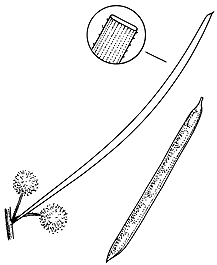Acacia viscidula Benth.
| Family Fabaceae
Subfamily Mimosoideae
|
Common name: sticky wattle
Acacia viscidula Benth. APNI* Synonyms: Acacia sp. C sensu Jacobs & Pickard (1981) APNI*
Racosperma viscidulum (Benth.) Pedley APNI*
Acacia viscidula var. angustifolia Benth. APNI*

Description: Erect or spreading shrub to 4 m high, rarely to 5 m high; bark smooth, grey or grey-brown; branchlets angled or flattened, resinous, ± hairy.
Phyllodes straight to slightly curved, ± linear, 4–8 cm long (range 2–11 cm long), 1–3 mm wide, with 5–7 (or sometimes only 3 or 4) longitudinal veins and sparse anastomosing veins, hairy only on margins or glabrous, resinous especially along veins, apex acute with a mucro; glands absent or 1 inconspicuous gland at base; pulvinus c. 2 mm long.
Inflorescences simple, 1 or 2 in axil of phyllodes; peduncles 3–5 mm long, hairy or glabrous; heads globose, 15–35-flowered, 4–7 mm diam., light to bright yellow.
Pods ± straight, sometimes becoming curved, raised alternately over seeds, ± straight-sided or occasionally slightly constricted between some seeds, 2–7 cm long, 2–3 mm wide, firmly papery, ± hairy; seeds longitudinal; funicle folded and thickened to form a 2-lobed aril.
Flowering: August–October.
Distribution and occurrence: chiefly on the Tablelands, north from Tamworth area, west to Mt Kaputar National Park and to east of Tenterfield. Grows in dry sclerophyll forest in granite-derived soils and in heath in crevices of granite outcrops.
NSW subdivisions: NC, NT, NWS
Other Australian states: Qld
The name refers to the viscid or sticky nature of the plant. Similar to Acacia lanigera which has pungent phyllodes and united sepals and generally occurs further to the south, and to A. dawsonii which has fewer flowers in the heads.
Text by P.G. Kodela (December 2005)
Taxon concept: P.G. Kodela & G.J. Harden, Flora of NSW Vol. 2 (2002)
APNI* Provides a link to the Australian Plant Name Index (hosted by the Australian National Botanic Gardens) for comprehensive bibliographic data
***The AVH map option provides a detailed interactive Australia wide distribution map drawn from collections held by all major Australian herbaria participating in the Australian Virtual Herbarium project.
|


